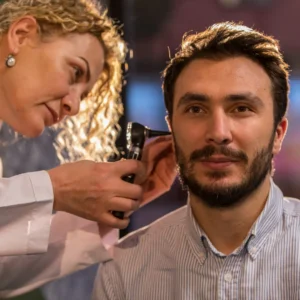Can You Reverse Hearing Damage?
Hearing loss affects millions worldwide, sparking questions about its reversibility. Let’s dive into this topic, shedding light on hearing damage and the truth behind reversing it.
Understanding Hearing and Its Complexities
Our ears are fascinating organs, crucial for hearing. The journey of sound starts at the outer ear, travels through the middle ear, and ends in the inner ear. Here, tiny hair cells convert sound waves into electrical signals. These signals then reach the brain, allowing us to perceive sound. Damage at any point in this process can lead to hearing loss. We assess this damage during hearing evaluations.
Exploring Hearing Damage
Hearing damage diminishes our ability to process sounds. It ranges from mild to severe and manifests in sensorineural, conductive, and mixed forms. Each type has unique causes and impacts hearing differently.
- Sensorineural Hearing Loss: The most prevalent form, resulting from inner ear or auditory nerve damage. Common culprits include loud noise exposure, aging, and genetics.
- Conductive Hearing Loss: Caused by obstructions in the outer or middle ear, preventing sound from reaching the inner ear. This type might be temporary or permanent.
- Mixed Hearing Loss: A combination of sensorineural and conductive hearing loss, adding complexity to diagnosis and treatment.
As we delve deeper into the world of hearing health, it’s clear that treatment options are as diverse as the types of hearing loss themselves. Let’s explore the range of treatments making waves and offering new hope to those affected by hearing loss.
Advanced Solutions for Conductive Hearing Loss
For those facing conductive hearing loss, the treatment landscape is promising. Beyond earwax removal and antibiotics, cutting-edge surgeries and implantable devices are transforming outcomes:
- Surgical Interventions: Procedures to repair the eardrum or reconstruct middle ear bones offer lasting solutions. These surgeries aim to correct structural issues and restore natural sound conduction.
- Bone-Anchored Hearing Aids (BAHAs): These devices bypass damaged outer or middle ear components, directly stimulating the cochlea through bone conduction. BAHAs represent a significant advancement for individuals not served by traditional hearing aids.
Revolutionizing Sensorineural Hearing Loss Management
Sensorineural hearing loss, once deemed irreversible, now has several innovative treatment avenues:
- Hearing Aids: Modern hearing aids are smarter, smaller, and more effective. They offer unparalleled customization, targeting specific frequencies affected by hearing loss and integrating seamlessly into daily life.
- Cochlear Implants: Cochlear implants bypass damaged hair cells in severe cases, sending sound signals directly to the auditory nerve. Recent advancements have improved their effectiveness and accessibility.
Combating Mixed Hearing Loss with Combined Approaches
Treating mixed hearing loss requires a nuanced strategy, combining treatments for both conductive and sensorineural components:
- Dual Treatment Protocols: Patients may benefit from a combination of surgery to address conductive issues and hearing aids or cochlear implants for sensorineural damage.
- Customized Hearing Solutions: Tailoring treatment to the individual’s unique hearing profile is critical. This may involve adjustable hearing aids or implant settings optimized for mixed hearing loss.
So, the treatment of hearing loss is rapidly evolving, with new technologies and therapies offering hope to those who have previously had limited options. From advanced surgical techniques to innovative hearing devices and promising regenerative treatments, the future is bright for those looking to improve their hearing health.

Diving Deeper into Hearing Loss Research
The quest to reverse hearing damage is an ever-evolving field, with scientists making remarkable strides. Let’s explore some groundbreaking research that offers a glimpse into the future of treating hearing loss.
Groundbreaking Genetic Research
A pivotal study has shown that activating a specific gene can reverse hearing loss in mice. This discovery opens doors to potential treatments for genetic hearing loss in humans. Researchers focused on a gene related to early-onset deafness. They observed significant hearing improvement in mice by activating this gene at a critical time after birth. This approach highlights a crucial developmental window for intervening in genetic hearing loss.
Regenerating Hair Cells: Learning from Nature
Another exciting area of research involves birds and fish, which are known for their ability to regenerate hair cells. Scientists are unraveling the mechanisms behind this regeneration, hoping to apply similar strategies to mammals. Recent studies have identified essential genes and pathways that could kickstart hair cell regeneration. This research is a significant leap toward regenerating cochlear hair cells in humans.
The ERBB2 Signaling Pathway
The discovery of the ERBB2 signaling pathway’s role in hair cell growth marks a significant advancement. By activating this pathway, researchers have stimulated the development of new hair cells in mammalian models. This process involves a cascade of cellular events, leading to the multiplication of cochlear support cells and the formation of new sensory hair cells. Such findings are crucial steps toward developing therapies for sensorineural hearing loss.
The Promise of Stem Cells
Stem cell research offers another promising avenue for reversing hearing damage. Scientists are exploring how stem cells, including hair cells, can regenerate in the ear. This approach could potentially restore hearing in cases where damage is currently irreversible.
Challenges and Future Directions
While these research findings are promising, challenges remain. Translating these breakthroughs from laboratory settings to practical human treatments involves complex hurdles. Researchers must address safety, efficacy, and the ability to target specific types of hearing loss.
The Path Ahead
The future of hearing loss treatment is bright, with ongoing research paving the way for innovative solutions. Continued investment in this research is essential for unlocking new therapies that could one day reverse hearing damage. As scientists understand the ear’s intricate workings and the factors contributing to hearing loss, the dream of restoring hearing becomes increasingly achievable.
In summary, while reversing hearing damage may not be a current reality for all types of hearing loss, the research landscape is vibrant and promising. These scientific endeavors not only deepen our understanding of hearing and its loss but also bring hope to millions affected by hearing impairments.
Prevention: A Key Strategy
While treatment options evolve, prevention remains paramount. Limiting noise exposure, adopting safe listening habits, and caring for your ears play critical roles. Regular checkups, avoiding ototoxic medications, and protecting against head injuries are also essential.
Embracing a Healthy Lifestyle
A healthy diet, stress management, and smoking cessation can also support hearing health. These proactive steps can significantly reduce the risk of hearing damage.
In fact, while reversing hearing damage entirely is not always possible, advancements in treatment and prevention offer hope. Understanding your hearing loss type and taking preventive measures are crucial to maintaining your hearing health. For those experiencing hearing issues, seeking professional advice is vital for effective management and improved quality of life.
Learn more about vitamins for hearing health.

Bringing It All Together
Navigating the world of hearing health can feel like a journey. Yet, understanding how to reverse hearing damage enriches this adventure. With advancements in treatments and breakthrough research, the question, “Can hearing damage be reversed?” gets more hopeful answers by the day.
Each type has a pathway toward better hearing, from conductive to sensorineural and mixed hearing loss. Whether it’s innovative hearing aids, regenerative therapies, or protective measures, steps toward reversing hearing damage are within reach.
Your Hearing Journey Starts Here
Don’t let questions about your hearing health go unanswered. Schedule with Stanford Hearing today. Let’s explore how we can support your hearing health journey together. Whether you’re looking to check on hearing damage or seeking ways to reverse hearing loss, we’re here to guide you every step of the way.
